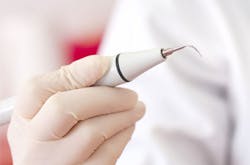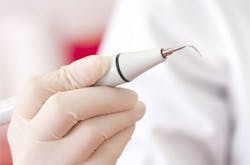Hygiene Message in a Bottle Mailbag: Chlorhexidine as an irrigant during ultrasonic scaler use
The "Hygiene Message in a Bottle Mailbag" is a new monthly feature of the e-newsletter, Pearls for Your Practice: The Product Navigator. Each month, Colleen Olson, RDH, BBA, the editorial director for the Hygiene Product Navigator,will answer reader-submitted questions to help you navigate your dental hygiene product decisions (and more!). This month, she replies to a question about the efficacy of chlorhexidine as an irrigant during ultrasonic scaler use.
ANSWER:
Great question!
A search at PubMed brought up in a variety of studies regarding the efficacy of using chlorhexidine as an irrigant during ultrasonic scaler use. The majority of what I found claimed there to be little, if any, improvement in outcomes with chlorhexidine use as opposed to water. Here are results from three studies I found on PubMed:
• "The results of this investigation demonstrate that the use of a chemical irrigant during the relatively short period of professional instrumentation does not product any additional significant reduction in traditional clinical measures of chronic periodontitis." (1)
• "The results from the study suggest that ultrasonic instrumentation in patients with moderate to severe periodontitis increases circulating levels of lipopolysaccharides (LPS) after 5 minutes and IL-6 concentrations 120 minutes after commencement of treatment, and that these effects are not affected by using 0.02% chlorhexidine as an irrigant instead of water." (2)
• "Ultrasonic mechanical instrumentation either with or without additional chlorhexidine use determined a significant reduction of supragingival plaque and gingival inflammation as well as a significant reduction of subgingival bacterial pathogens. The additional use of chlorhexidine did not result in any additional clinical and microbiological benefit with respect to mere ultrasonic mechanical instrumentation." (3)
Curious to know what people are doing in practice, I took an informal poll of 10 periodontists I know to see what irrigant was being used for scaling and root planing and perio maintenance patients in each of their practices. Of the periodontists I contacted, only one uses an irrigant other than water.
The bottom line seems to be that the idea behind using chlorhexidine as an irrigant during ultrasonic scaling was a good one, but the practice of doing so has failed to produce significant clinical benefits.
References
1. Chapple IL, Walmsley AD, Saxby MS, Moscrop H. Effect of subgingival irrigation with chlorhexidine during ultrasonic scaling. J Periodontol. 1992;63(10):812–816.
2. Lee MK, Ide M, Coward PY, Wilson RF. Effect of ultrasonic debridement using a chlorhexidine irrigant on circulating levels of lipopolysaccharides and interleukin-6. J Clin Periodontol. 2008;35:415–419.
3. Guarnelli ME, Franceschetti G, Manfrini R, Trombelli L. Adjunctive effect of chlorhexidine in ultrasonic instrumentation of aggressive periodontitis patients: a pilot study. J Clin Periodontol. 2008;35:333–341.
MORE HYGIENE MAILBAGS:
June 2016 | Is a headlight worth the cost?
May 2016 | A different kind of saliva ejector
April 2016 | Products for dry mouth relief
Editor's Note: Do you have a question for Colleen? Is there a product you'd like to see her review? Or would you like to submit your own hygiene product "Pearl"? Send an email to [email protected]. You might just see it in the Hygiene Product Navigator! If you're not a Product Navigator subscriber, click here to sign up.


